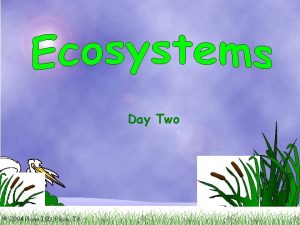Introducing 2004 Plano ISD Plano TX Ecology the













- Slides: 13

Introducing © 2004 Plano ISD, Plano, TX

Ecology the study of the relationships between biotic and abiotic factors in environments eco- = environment, habitat -logy= study of eco eco climate system tourism © 2004 Plano ISD, Plano, TX epidemi climat zoology

Levels of Organization living and any all one all smallest group interacting organisms place individual of unit that large region all different nonliving populations life of similar living of organs the can living thing same cells exist in with typical kinds things of to an organized kind on working ecosystem living Earth in plants and interacting tissues work one together area animals that within workinga includes certain together area several ecosystems cell © 2004 Plano ISD, Plano, TX

Ecosystem includes all abiotic and biotic factors in one particular environment Biotic Factors Abiotic Factors the living parts of an ecosystem the nonliving parts of an ecosystem © 2004 Plano ISD, Plano, TX

Examples of Ecosystems Mountains Coral Arizona Reefin. Desert in. Colorado Belize © 2004 Plano ISD, Plano, TX

Ecosystems do not necessarily have clear boundaries due to biotic and abiotic changes can change daily as things move from one ecosystem to another Biotic Abiotic migration, seed dispersal flood, erosion, drought © 2004 Plano ISD, Plano, TX

Bio Biotic Factors include plants, animals, fungi, microorganisms Bio = life bio bio technology mechanics bio statistics feedback biot graphy sphere logy ic bio © 2004 Plano ISD, Plano, TX

Examples of Biotic Factors © 2004 Plano ISD, Plano, TX

Biotic Factors interact with each other in complex such as ways also interact with abiotic factors in the ecosystem parasitism mutualism competition dependent upon water, minerals, temperature, light **Abiotic factors DETERMINE Biotic factors** © 2004 Plano ISD, Plano, TX

Biotic Factors Living organisms are affected by the living components of its environment. n o i t peti Com • • Food Shelter Mates Light © 2004 Plano ISD, Plano, TX Preda t ors Microbes • Dinosaur example

A Abiotic Factors include air, water, soil, temperature, wind, source of energy (usually sun) a, an = not, without aabiotic musia moral toxic © 2004 Plano ISD, Plano, TX

Examples of Abiotic Factors © 2004 Plano ISD, Plano, TX

More Examples of Abiotic Factors • Abiotic factors include: – Sand – Elements like: • Nitrogen • Calcium – Special events such as: • • • Fires Hurricanes Floods Volcanic eruptions Tsunamis © 2004 Plano ISD, Plano, TX
 Plano isd niche
Plano isd niche Diferencia entre gran plano general y plano general
Diferencia entre gran plano general y plano general What type of business is kfc
What type of business is kfc Templates for introducing quotations
Templates for introducing quotations Body paragraph starters
Body paragraph starters Email to an exchange student
Email to an exchange student They say i say moves that matter in academic writing
They say i say moves that matter in academic writing Chapter 1 introducing psychology
Chapter 1 introducing psychology Define politics
Define politics Introducing family members in french
Introducing family members in french Introducing neeta anil said
Introducing neeta anil said Relocation diffusion definition
Relocation diffusion definition Signal phrases for introducing quotations
Signal phrases for introducing quotations Introducing and naming new products and brand extensions
Introducing and naming new products and brand extensions
























